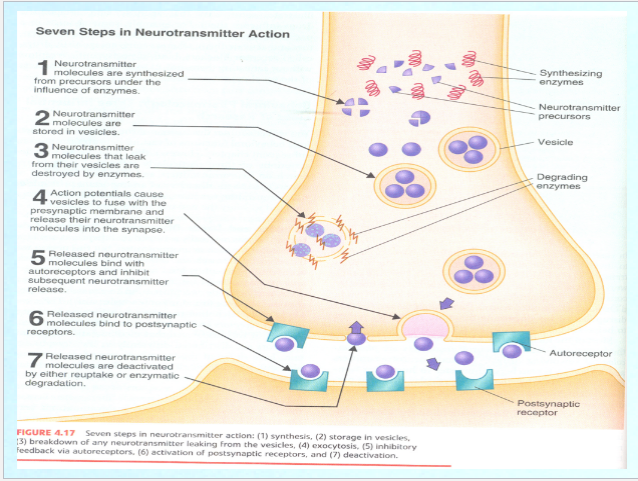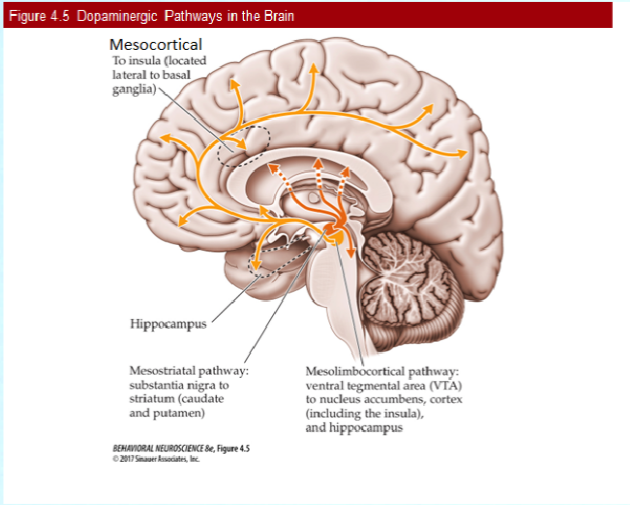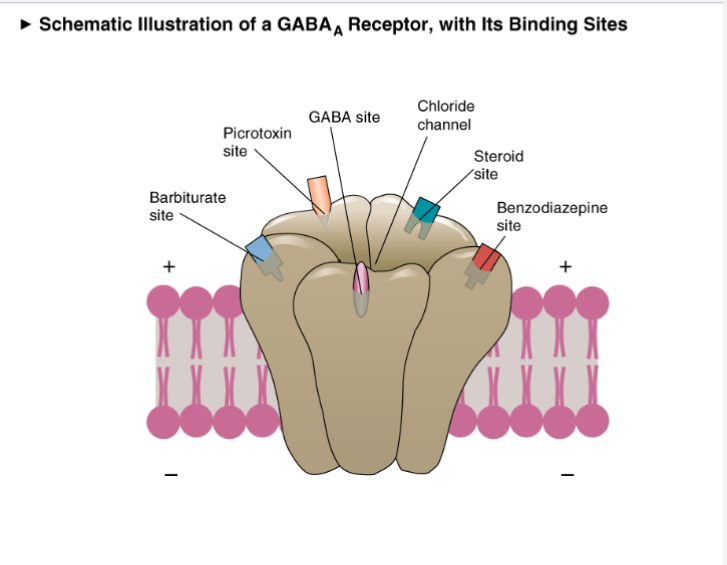Behavioral Neuroscience - Neurotransmitters
Neural communication consists of two components
Electrical current w/in a neuron
chemical transmission between neurons
Neurotransmitter: A chemical that is released from a nerve cell which thereby transmits an impulse from a nerve cell to another nerve, muscle, organ, or other tissue.
A neurotransmitter is a messenger of neurologic information from one cell to another
allows info to travel through the nervous sys
most meds and verbal treatments exert effect by altering the functioning NTs
Criteria for NT
chemical released onto a target cell:
substance exists in presynaptic axon terminal and is synthesized in presynaptic cells
is released when action potential reaches axon terminals
receptors for the substance exist on the post synaptic cell
blocking substance release prevents changes in postsynaptic cell
can activate (EPSP or IPSP) more than one neuron at a time (versatility in neurotransmitters)

Acetylcholine (ACH)
General Charcteristics:
Found through the nerve sys
receptors called cholinergic primary NT secreted by afferent axons of the central NS
likely the first NT to have evolved
Functions
All muscular movement is accomplished by the release of acetylcholine (EPSPs for voluntary muscles)
Nicotinic receptors --- excites voluntary muscles through the release of ACH
botulinum toxin --- improperly canned food --- prevents the release of ACH -- paralysis
inhibits target organs of the parasympathetic branch of the autonomic NS
increased heart rate, and blood pressure…allows the sympathetic NS to become active
Muscarinic - inhibits involuntary muscles
induces REM sleep; released from neurons in the Pons
Pons partially controls brain areas called the RAS (reticular activating system); controls overall brain arousal
when Pons (RAS) is inhibited by Ach, REM sleep occurs
Pons → releases Ach → inhibits RAS
Cognitive functions of Ach
allows for movement of the voluntary muscles (released by efferent spinal and cranial nerves)
inhibits the parasympathetic NS, allows for activation of the sym NS
allows for induction of REM sleep by inhibiting the Pons
Dopamine
Basic characteristics:
Pleasure and motivation (activates the nucleus accumben and septum)
site of action for many therapeutic and recreational drugs (cocaine, amphetamines)
source of many psychological disorders
receptors are called dopaminergic, different subclasses will be discussed w/ schizophrenia
associated w/ schizophrenia - drugs that block DA receptors can be used to treat schizophrenia
(neuroleptic)
in schizophrenia, you have too many dopamine receptors and body produces too much dopamine
drugs such as cocaine dopamine worsen the effects of schizophrenia
neuroleptic: a type of antipsychotic; blocks dopamine receptors
referred as a receptor antagonist
Mesolimbocortical Dopaminergic system
a neurological pathway
Associated with activity of the limbic system; associated with emotional experiences (love, joy, anger, hate, pleasure); also learning and memory
limbo - overactive in schizophrenia
activates nucleus accumbens, amygdala, and hippocampus
any substance (or activity) that activates these areas produce pleasure fear or other strong emotions --- not usually under conscious control
Mesolimbocortical Dopaminergic system also activates the pre-frontal cortex of the brain; associated with the ability to form long-term plans and goals
Mesostriatal (also nigrostriatal) Dopamerningeic sys
not affected in schizophrenia,
associated with activity of the basal ganglia
basal ganglia: area of the brain associated with the passage of motor information from the PFC throughout the brain
damaged in Parkinson’s disease
passes motor info to cerebellum which organizes the movement and sends it to either the spinal or cranial nerves
Parkinson’s disease = damage to dopaminergic cells in the basal ganglia → loss of control over voluntary movement
Damage to the cerebellum (and dopamine), loss of balance = movement side effects associated with neuroleptic

Implications for behavior and cognition
Most pleasurable activities (innate and external) activate DA neurons in the nucleus accumbens
Overactivity in the mesolimbic system (part of the mesolimbocortical) → hallucination and delusions
allows passage of movement info thru the brain
damaged in Parkison’s disease
allows PFC to produce IPSP to help regulate behavior
Norepinephrine (NE)
Basic characteristics
aka adrenaline
only NT formed in the vesicle
comes from dopamine (precursor), if a specific enzyme is present, dopamine is converted to ME
receptors = noradrenergic; largely excitatory, similar in chemical nature to epinephrine which is a hormone associated with arousal
Functions
Controls overall levels of arousal and wakefulness
activates sys call reticular activation sys (RAS)
begins in area of pons (discussed earlier) called Reticullar Formation-- controls overall levels of cortical arousal leads to alertness, active cortex
regulates circadian cycle - daily cycle of arousal
many antidepressant medication activate NE
combats lack of energy, arousal, and pleasure (depression symptoms)
Most stimulant drugs to activate NE (from Aderall to cocaine = produce arousal)
can be inhibited by Ach; this inability leads to many sleeping disorder
Implications for cognition
creates EPSPs which enhance cortical activity
Makes us alert and active through activation of the Reticular Activating System
also activates limbic system and dopamine as result
Associated with psychology disorder such as depression and ADD
antidepressants increases NE
ADD under-active → seek out external stimulation
inability to inhibit could lead to sleep disorders
Serotonin (5-HT)
Regulatory NT affecting many neural functions
many diff types of receptors (9 so far) --- referred to as serotinergic
source of many (most) anti-depressant meds
selective serotonin reuptake inhibitors (SSRI)
important in regulating emotional behavior
related to depression (lo)
depression is related to low levels of serotonin
drugs that block 5-HT reuptake can be used to treat depression
Increases the nervous sys’ ability to utilize NE and DA (makes it more receptive) = agonist
serotonin increases receptor affinity for norepinephrine by activating an enzyme that changes the conformation of the receptor
Important in regulation of reaction to pain
Found in the Raphe nuclei
When active the raphe nucleus inhibits transmission of pain to brain (thru activation of the endorphins)
RN activates 5-HT which activates endorphins which block the passage of pain through the spinal cord
Amino acids - GABA
Inhibitory NTs found in CNS
important in control of brain’s electrical activity and defense against stress and anxiety
major inhibitory NT in the mammalian brain
in many indivs. w/ anxiety, the brain shows decreased ability to utilize GABA (an abnormal genetic condition)
underactivity is associated w/ “out of control” brain activity such as seizures
Receptors have binding sites that when activated make the neuron more sensitive to GABA
anti-anxiety drugs (benzodiazepines) activate the companion sites
when activated the affinity of the main receptor is increased (an allosteric activator)

disruption of GABA neural systems associated w/ most anxiety-related disorders
support animals increase GABA activity
Glutamate
Principle excitatory NT
important in learning and memory and overall brain activity
most important receptor type is called and NMDA receptor
when NMDA receptor activated -- allows for physical changes of neurons, allow for the formation new memories
allows new dendritic branches to grow (only with NMDA)
associated w/ the process of increased dendritic branching = long-term potentiation
glutamate works with NE to keep the brain active and alert - more general than NE
drugs such as ketamine (sedative) block activity of glutamate receptors
glutamate decreases GABA activity, helps brain stay active
inhibiting the inhibitor
associated w/ a type of neuroplasticity
Endogenous opioids
regulates the body’s response to pain
activates circuitry which inhibits the passage of pain (emotional and physical) info
ultimate effect = produces IPSP which interferes w/ pain transmission
3 versions of endogenous opioids have been identified w/ each influencing different areas of brain
endorphins: reduce the perception of physical pain; activated by serotonin
enkephalins: found in limbic system, inhibits emotional pain
dynorphins: found in cortex, inhibits “cortical” pain (eg. existential pain, what ifs, etc.)
all of these are activated by narcotics
narcotics (opioids) activate endorphins receptors -- associated with pain reduction (all three endogenous opioid receptors)]
interesting fact - activity associated with estrogen levels in women
lithium works on GABA
inhibits manic episodes for BPD by activating GABA
increases NE and 5HT (and DA) for depression for BPD